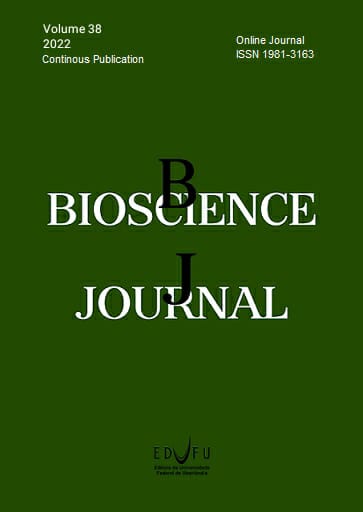The effects of stress reduction strategies of breathing technique relaxation programme and positive psychology on biochemical variable response among schoolteachers
DOI:
https://doi.org/10.14393/BJ-v38n0a2022-54176Keywords:
Biochemical variables, Salivary cortisol, Schoolteachers, Stress reduction.Abstract
We aimed to investigate the effects of job stress on the biochemical variables of schoolteachers before and after stress reduction strategies. In 2019, 200 schoolteachers (98 males, 102 females) in the private and fully aided higher secondary schools of urban and rural areas in Vellore, India were enrolled in the study based on the principle of consecutive sampling. Questionnaires were used to investigate demographic characteristics and occupational stress-related factors. Fasting blood glucose was detected by venous plasma and a biochemical analyser with the cut-off thresholds method. Salivary cortisol was determined by the specific enzyme-linked immunosorbent assay kit method. Total cholesterol in serum was determined by the CHOD-PAP method. Serumalbumin was detected by the bromocresol green dye-binding method on a Roche Modular DP analyser (Roche Diagnostics). Blood pressure was measured by aneroid sphygmomanometers. Levels of fasting blood glucose, salivary cortisol, albumin and cholesterol were lower in the high-tension group than those in the low-tension group. Those of the high-coping strategy group were higher than those of the low-coping strategy group. Systolic blood pressure and diastolic blood pressure significantly reduced among the intervention groups after administering the relaxation response programme for three and six weeks, respectively, to urban and rural school teachers. Occupational stress can lead to increased salivary cortisol, cholesterol, albumin, blood glucose and blood pressure levels. The relaxation response programme resulted in quantifiable improvements in physiological markers of stress in rural and urban schoolteachers.
References
AKTER, R., et al. Effect of Obesity on Fasting Blood Sugar. Mymensingh medical journal. 2017, 26(1), 7-11.
AUSTIN, A.W., PATTERSON S.M. and VON KANEL, R. Stress-hemoconcentration: plasma volume changes or splenic contraction? A Reply to Engan and Schagatay. Annals of behavioral medicine. 2015, 49(4), 636-637. https://doi.org/10.1007/s12160-015-9708-1
BARZEHKAR, S., et al. Investigating Changes in Serum Biochemical Parameters in Opium Addicts Before and During Addiction Treatment. Addiction & health. 2016, 8(4), 211-217.
CHAUDHARY, S. and SRIVASTAVA, S.K. Stress in rural and urban adolescents. International Journal of Research in Social Sciences. 2017, 7(3), 118-124.
CUMMINGS, T.G. and COOPER, C.L. A cybernetic framework for studying occupational stress- In Managerial. Human Relations. 1979, 32(5), 395-418. https://doi.org/10.1177/001872677903200504
DAWN, S., et al. A study on job related stress among schoolteachers in different schools of West Bengal, India. Eastern Journal of Psychiatry. 2017, 19(1), 12-17.
DELANGHE, S., et al. Binding of bromocresol green and bromocresol purple to albumin in haemodialysis patients. Clinical Chemistry and Laboratory Medicine (CCLM). 2018, 56(3), 436-440. https://doi.org/10.1515/cclm-2017-0444
HAWLEY, J.M., et al. Serum cortisol: an up-to-date assessment of routine assay performance. Clinical chemistry. 2016, 62(9), 1220-1229. https://doi.org/10.1373/clinchem.2016.255034
HERSOUG, A.G., WAERSTED, M. and LAU, B. Nondirective meditation used in stress management. Nordic Psychology. 2018, 70(4), 290-303. https://doi.org/10.1080/19012276.2018.1443278
HUNTER, M.R., GILLESPIE, B.W. and CHEN, S.Y.P. Urban nature experiences reduce stress in the context of daily life based on salivary biomarkers. Frontiers in psychology. 2019, 10, 722. https://doi.org/10.3389/fpsyg.2019.00722
ISMAIL, N.H. and NOOR, A. Occupational stress and its associated factors among academician in a research university, Malaysia. Malaysian Journal of Public Health Medicine. 2016, 16(1), 81-91.
JENA, S.K., MISRA, A.K. and MOHANTY, A. Effect of examination stress on blood sugar in medical students. Chrismed Journal of Health and Research. 2016, 3(4), 268. https://doi.org/10.4103/2348-3334.190573
KULIG, W., et al. Cholesterol under oxidative stress—How lipid membranes sense oxidation as cholesterol is being replaced by oxysterols. Free radical biology and medicine. 2015, 84, 30-41. https://doi.org/10.1016/j.freeradbiomed.2015.03.006
LAMEGO, M., et al. CercacorLabs Inc. Blood pressure measurement method. U.S. Patent 9,649,054. May 16, 2017. Available at: https://patents.justia.com/assignee/cercacor-laboratories-inc
MOMOZONO, A., et al. Oxidised Met 147 of human serum albumin is a biomarker of oxidative stress, reflecting glycaemic fluctuations and hypoglycaemia in diabetes. Scientific Reports. 2020, 10(5), 1-11. https://doi.org/10.1038/s41598-019-57095-2
MUNNE-BOSCH, S. and PINTO-MARIJUAN, M. Free radicals, oxidative stress and antioxidants. Encyclopedia of Applied Plant Sciences (Second Edition). 2017, 1, 16-19. https://doi.org/10.1016/B978-0-12-394807-6.00077-0
OUELLETTE, R.R., et al. Teacher job stress and satisfaction in urban schools: Disentangling individual-, classroom-, and organizational-level influences. Behavior therapy. 2018, 49(4), 494-508. https://doi.org/10.1016/j.beth.2017.11.011
ROSS, K.M., et al. How stable are diurnal cortisol activity indices in healthy individuals? Evidence from three multi-ware studies. Psychoneuroendocrinology. 2014, 39, 184-193. https://psycnet.apa.org/doi/10.1016/j.psyneuen.2013.09.016
SCHULZ, P., et al. Increased free cortisol secretion after awakening in chronically stressed individuals due to work overload. Stress Medicine. 1998, 14(2), 91-97. https://doi.org/10.1002/(SICI)1099-1700(199804)14:2<91::AID-SMI765>3.0.CO;2-S
SEVINC, G., et al. Common and dissociable neural activity after mindfulness-based stress reduction and relaxation response programs. Psychosomatic medicine. 2018, 80(5), 439-451. https://doi.org/10.1097/PSY.0000000000000590
SINGH, K. Nutrient and stress management. Journal of Nutrition & Food Sciences. 2016, 6(4), 1-6. http://dx.doi.org/10.4172/2155-9600.1000528
SLUITER, J.K., VAN DER BEEK, A.J. and FRINGS-DRESEN, M.H. Medical staff in emergency situations: severity of patient status predicts stress hormone reactivity and recovery. Journal of Occupational and Environmental Medicine. 2003, 60(5), 373-374. http://dx.doi.org/10.1136/oem.60.5.373
SOZEN, E. and OZER, N.K. Impact of high cholesterol and endoplasmic reticulum stress on metabolic diseases: An updated mini-review. Redox biology. 2017, 12, 456-461. https://doi.org/10.1016/j.redox.2017.02.025
STIEFEL, L., et al. School wellness programs: magnitude and distribution in New York City Public schools. Journal of School Health. 2017, 87(1), 3-11. https://doi.org/10.1111/josh.12463
VON DER EMBSE, N., et al. Teacher stress interventions: A systematic review. Psychology in the Schools. 2019, 56(8), 1328-1343. https://doi.org/10.1002/pits.22279
WENJUAN, W., et al. Effects of Occupational Stress on Blood Lipids, Blood Sugar and Immune Function of Doctors. Iranian Journal of Public Health. 2019, 48(5), 825-833. http://ijph.tums.ac.ir/index.php/ijph/article/view/17108
YANG, Y., et al. Self-perceived work-related stress and the relation with salivary IgA and lysozyme among emergency department nurses. Occupational and Environmental Medicine. 2002, 59(5), 836-841. http://dx.doi.org/10.1136/oem.59.12.836
Downloads
Published
Issue
Section
License
Copyright (c) 2022 Cathrine Thephilah, Swaminathan Aruna, Rajagopalan Vijayaragahavan

This work is licensed under a Creative Commons Attribution 4.0 International License.





